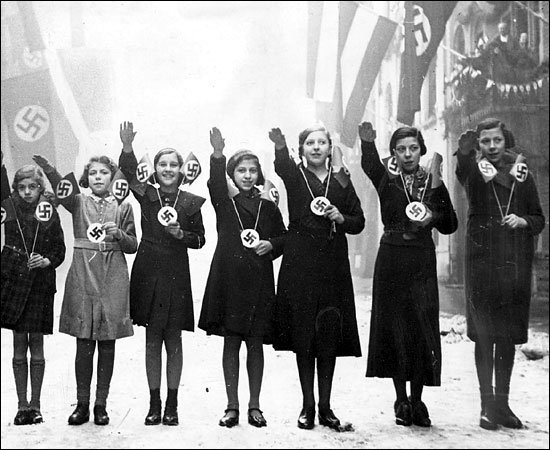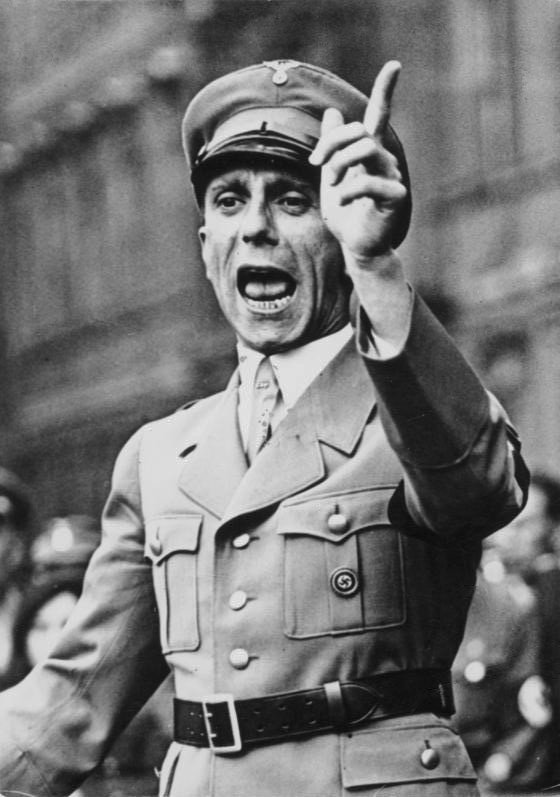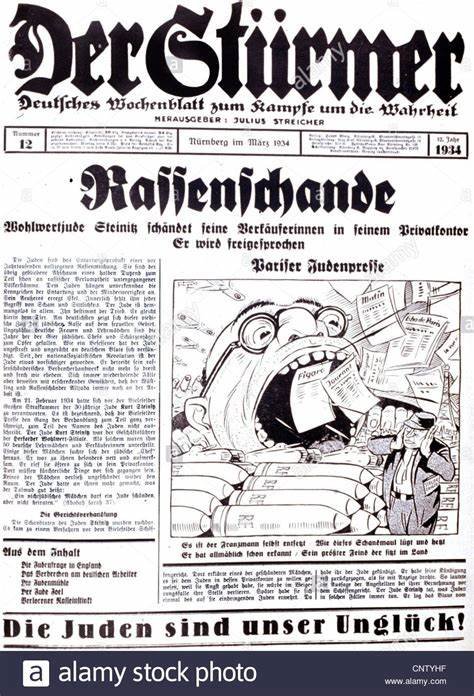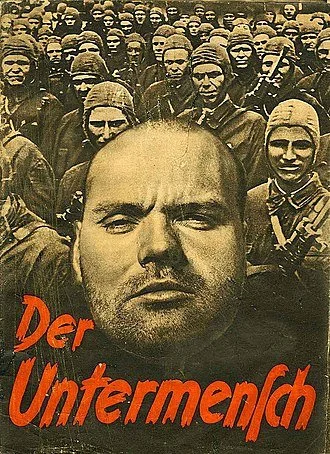
“Propaganda tries to force a doctrine on the whole people… Propaganda works on the general public from the standpoint of an idea and makes them ripe for the victory of this idea.”
Adolf Hitler wrote these words in his book Mein Kampf (1926), in which he first advocated the use of propaganda to spread the ideals of National Socialism—among them racism and anti-Semitism.
Polorisation
Communicating the Nazi Message
Following the Nazi seizure of power in 1933, Hitler established a Reich Ministry of Public Enlightenment and Propaganda headed by Joseph Goebbels. The Ministry's aim was to ensure that the Nazi message was successfully communicated through art, music, theater, films, books, radio, educational materials, and the press.
There were several audiences for Nazi propaganda. Germans were reminded of the struggle against foreign enemies and Jewish subversion. During periods preceding legislation or executive measures against Jews, propaganda campaigns created an atmosphere tolerant of violence against Jews, particularly in 1935 (before the Nuremberg Race Laws of September) and in 1938 (prior to the barrage of antisemitic economic legislation following Kristallnacht). Propaganda also encouraged passivity and acceptance of the impending measures against Jews, as these appeared to depict the Nazi government as stepping in and “restoring order.”
Real and perceived discrimination against ethnic Germans in east European nations which had gained territory at Germany's expense following World War I, such as Czechoslovakia and Poland, was the subject of Nazi propaganda. This propaganda sought to elicit political loyalty and so-called race consciousness among the ethnic German populations. It also sought to mislead foreign governments—including the European Great Powers—that Nazi Germany was making understandable and fair demands for concessions and annexations.
After the German invasion of the Soviet Union, Nazi propaganda stressed to both civilians at home and to soldiers, police officers, and non-German auxiliaries serving in occupied territory themes linking Soviet Communism to European Jewry, presenting Germany as the defender of “Western” culture against the “Judeo-Bolshevik threat," and painting an apocalyptic picture of what would happen if the Soviets won the war. This was particularly the case after the catastrophic German defeat at Stalingrad in February 1943. These themes may have been instrumental in inducing Nazi and non-Nazi Germans as well as local collaborators to fight on until the very end.
Ministry of Public Enlightenment and Propagandaheaded by Joseph Goebbels
Film
Films in particular played an important role in disseminating racial antisemitism, the superiority of German military power, and the intrinsic evil of the enemies as defined by Nazi ideology. Nazi films portrayed Jews as "subhuman" creatures infiltrating Aryan society. For example, The Eternal Jew (1940), directed by Fritz Hippler, portrayed Jews as wandering cultural parasites, consumed by sex and money. There were many other films made under the instruction of Goebbels that were intentinally made to turn the German public against the Jews.
Jud Süß, the Jew" is a 1940 Nazi German historical drama and propaganda film produced by Terra Film at the behest of Joseph Goebbels. It is considered one of the most antisemitic films of all time. The film has been characterized as "one of the most notorious and successful pieces of antisemitic film propaganda produced in Nazi Germany." It was a great success in Germany, and was seen by 20 million people. Although its budget of 2 million
The Eternal Jew is a 1940 antisemitic Nazi propaganda film, presented as a documentary. The film's initial German title was Der ewige Jude, the German term for the character of the "Wandering Jew" in medieval folklore
Vienna 1910 (German: Wien 1910) is a 1943 German biographical film directed by Emerich Walter Emo and starring Rudolf Forster, Heinrich George, and Lil Dagover. It is based on the life of Mayor of Vienna Karl Lueger. Its antisemitic content led to it being banned by the Allied Occupation forces following the Second World War.
Albert Forster, the Gauleiter of Danzig (now Gdańsk), wrote in 1937:
With pleasure, I say that the Stürmer, more than any other daily or weekly newspaper, has made clear to the people in simple ways the danger of Jewry. Without Julius Streicher and his Stürmer, the importance of a solution to the Jewish question would not be seen to be as critical as it actually is by many citizens. It is therefore to be hoped that those who want to learn the unvarnished truth about the Jewish question will read the Stürmer.
Newspapers
Newspapers in Germany, above all Der Stürmer (The Attacker), printed cartoons that used antisemitic caricatures to depict Jews. After the Germans began World War II with the invasion of Poland in September 1939, the Nazi regime employed propaganda to impress upon German civilians and soldiers that the Jews were not only subhuman, but also dangerous enemies of the German Reich. The regime aimed to elicit support, or at least acquiescence, for policies aimed at removing Jews permanently from areas of German settlement.
Most of the paper's readers were young people, and people from the lowest strata of German society. Copies of Der Stürmer were displayed in prominent red Stürmerkästen (display boxes) throughout the Reich. As well as advertising the publication, the cases also allowed its articles to reach those readers who either did not have time to buy and read a newspaper in depth, or could not afford the expense. In 1927, Der Stürmer sold about 27,000 copies every week. By 1935, its circulation had increased to around 480,000
Leaflets and Pamphlets
The Nazis described the Jews as Untermenschen (subhumans), this term was utilized repeatedly in writings and speeches directed against them, the most notorious example being a 1942 SS publication with the title "Der Untermensch" which contains an antisemitic tirade. In the pamphlet "The SS as an Anti-bolshevist Fighting Organization", Himmler wrote in 1936: "We shall take care that never again in Germany, the heart of Europe, will the Jewish-Bolshevistic revolution of subhumans be able to be kindled either from within or through emissaries from without."
Posters
This Nazi propaganda poster reads, "Behind the enemy powers: The Jews."
A flyer comparing Jews to diseases. It reads "Tuberculosis Syphilis Cancer are curable ... It is necessary to finish the biggest curse: The Jew!"
This poster, which reads "Jews are lice," was plastered across Poland, spreading fear that Jewish people carried typhus.
Radio
The fact that the Volksempfänger (Peoples radio) was a propaganda machine was never hidden, but because it was cheap, and could play music along with Hitler’s speeches, most people bought one anyway. As historian Eric Rentschler cites in the New German Critique, “By 1941 65% of German households owned a ‘people’s receiver’ [Volksempfänger].” Although they were designed to tune in only to local stations, it was possible to get international transmissions like the BBC in the evening hours. Listening to these “enemy” stations became a crime punishable by death during World War II.
The Volksempfänger recalls the how the Third Reich eliminated the freedom of press, and replaced it with propaganda that infiltrated every facet of daily life. Although mass communication has now expanded beyond the radio to include television and social media, it’s still important to be aware of who controls the medium and dominates its messages.
“We want a radio that reaches the people, a radio that works for the people, a radio that is an intermediary between the government and the nation, a radio that also reaches across our borders to give the world a picture of our character, our life, and our work," Goebbels proclaimed.
To make that happen, Geobbels had seized control of the Reichs-Rundfunk-Gesellschaft—the Reich Broadcasting Corporation— a national network of regional broadcasting companies. After solidifying control of the broadcast infrastructure, he imposed rules on permissible content. His final task was to make sure everyone had access to an affordable radio receiver. With that he had the Ear of almost every German in the country to listen to his Antisemitic speeches. Genius!
The Police State
In addition to the National uses of Propaganda there was also Police control. The Nazi authorities left the citizens in no doubt who were in charge, they controlled the way people behaved and even how they thought. Everyone'd had to behave especially the Jews or they knew only to well the consequences. This is propaganda in its extreme, raw form but propaganda none the less. Loudspeakers in public places also blared out Nazi propaganda and anyone who disagreed where left to the mercy of the Authorities.
By August 1934 Hitler was a dictator with absolute power. In order to maintain this power he needed organisations that could control the population to ensure absolute loyalty to the Führer. After the demise of the SA on the Night of the Long Knives, there were three main interlinked organisations (in addition to the regular German police force) involved in controlling the German people through spying, intimidation and if necessary imprisonment:
Schutzstaffel (SS) - Led by Heinrich Himmler, the SS was the most important of these organisations and oversaw the others. Initially set up as Hitler’s personal bodyguard service, the SS was fanatically loyal to the Führer. It later set up concentration camps where ‘enemies of the state’ were sent.
Gestapo - This was the Nazis’ secret police force. Its job was to monitor the German population for signs of opposition or resistance to Nazi rule. It was greatly helped by ordinary German people informing on their fellow citizens.
Sicherheitsdienst (SD) - This was the intelligence gathering agency of the SS. It was responsible for the security of Hitler and other top Nazis and was led by Himmler’s right hand man, Reinhard Heydrich.
A brochure for the Volksempfänger highlights the radio's especially beautiful tone and its adherence to safety standards set by the Federation of German Electrical Engineers. Note the swastika
Loudspeakers in public places also blared out Nazi propaganda. Much of the information Germans received reinforced the message of Aryan racial superiority whilst demonising the Jews and other ‘enemies’ of the regime.
Analysing Nazi Anti-Semitic Propaganda Imagery












